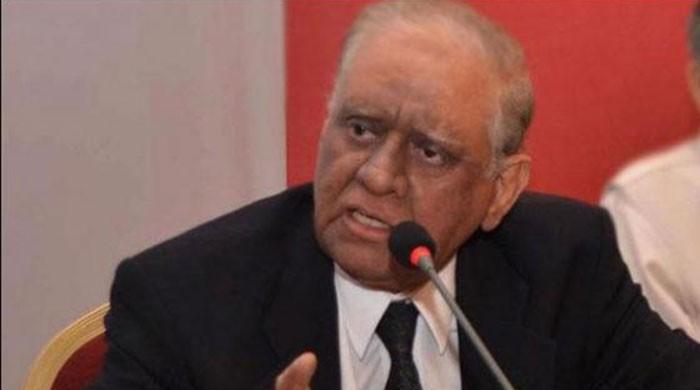How can a Judge be judged?
November 21, 2016

It was sometime in January 2000; Pervez Musharraf had a message for the then Chief Justice of Pakistan, Saeeduzzaman Siddiqui – now the Governor of Sindh: ‘Take oath under the PCO, or go home.’ And who conveyed this message, the story was narrated over seven years later.
Sometime in 2007, there was a talk show being aired at a news channel. Cyril Almeida was the host of the show; discussing the events that took place in the aftermath of the 1999 military coup d'état with four invited guests in studio. One of them was Saeeduzzaman Siddiqui.
The former chief justice began reluctantly. But as the host insisted, he finally spoke. Pointing at Lieutenant-General (retired) Moinuddin Haider, who was one of the guests in the show, he said: “… he was one of them.” In fact, Moinuddin was clearly seen restless that moment. After all, he was Interior Minister those days.
The conversation that followed finally ended up revealing that four generals sent to him by Pervez Musharraf, besides Moinuddin Haider, were Lieutenant-General (retired) Ehsan ul Haq, Lieutenant-General (retired) Mahmud Ahmed and Brigadier-General (retired) Javed Ashraf Bajwa.
After discussing with the generals, Siddiqui refused the proposal. He and his family were put under house arrest, as a result. And this is how he was repaid for his competence and integrity.
Without any shadow of doubt, Justice Saeeduzzaman Siddiqui was a high caliber jurist and legislator, having countless instances that establish his prominence and professional standing. This is evident in the fact that as the news of his resignation came, judicial fraternity from many western countries praised his stand and even some awarded him with honorary membership.
What would be more relevant is yet another story that traces back to the day when Nawaz Sharif’s first government was restored in May 1993.
Ghulam Ishaq Khan, exercising his powers as President under Article 58-2(b), had dissolved Nawaz Sharif’s government in April that year. In a dramatic move though, he was restored to power the very next month by an 11-member Supreme Court bench. Being the lone dissenter, the Chief Justice Sajjad Ali Shah had somehow waged a war against Nawaz Sharif.
Sharif’s retaliation came when he irritated the CJ by establishing Special Trial Courts in violation of the Constitution. The situation turned critical when he abolished five vacant positions of judges for the apex court. Out of political pressure, he had to restore the positions but never allowed any appointment. The tussle continued.
After a few days, CJ, heading a three-member bench, suspended the 13th Amendment, restoring the powers of the President to dissolve National Assembly. But within a few minutes, as has been described at some points, another bench set aside the judgment by pronouncing a stay. This was a parallel bench, said to have been ‘constituted’ by Sharif’s supporters in the superior judiciary. This 10-member bench was headed by none other than Justice Saeeduzzaman Siddiqui.
Abolishing such an autocratic law would have been a wise judicial act under any other condition. But in this particular case, it seems to have targeted the Chief Justice of Pakistan. The reason was very obvious – the continuing rift between CJ and PM. To trigger further curiosity, Saeeduzzaman Siddiqui’s bench had granted the stay without receiving any formal petition. This was not the end.
Another bench comprising two judges including Justice Saeeduzzaman Siddiqui, in the meantime, took up the controversy over the appointment of Chief Justice Sajjad Ali Shah, passing an interim order that suspended his function as the CJ. The order came, as is said, in the wake of his political appointment, during Benazir Bhutto's tenure.
The rift escalated. More judges and jurists got involved in the controversy; parallel judgments came and the country witnessed the worst constitutional crises ever witnessed in the history. Amidst the mounting pressure, Nawaz Sharif was summoned in contempt of court, the Supreme Court was stormed and there was dire need for an amicable and immediate solution.
The controversy finally met its end; but not before sending the Chief Justice of Pakistan home. This was how the crises that emerged out of the two orders of Justice Saeeduzzaman Siddiqui– one nullifying Sajjad Ali Shah’s verdict of restoring the Article 58-2(b) and another, suspending his functions as Chief Justice of Pakistan – came to an end. And this is how the rubble of the disastrous crises settled into restless quietness.
—The writer is a senior journalist working for Geo News / Jang Group.











